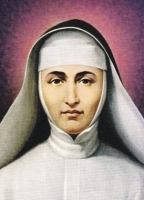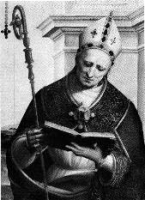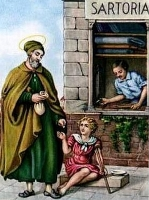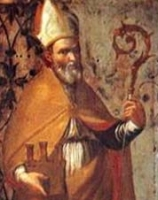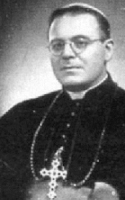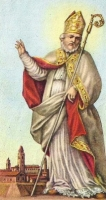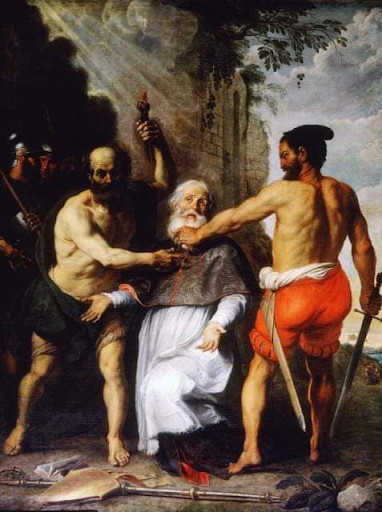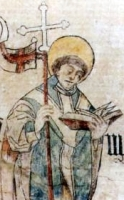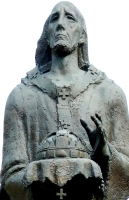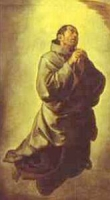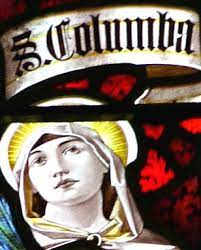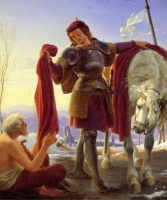Saint Frances Xavier Cabrini
புனிதர் ஃபிரேன்செஸ் சேவியர் கேப்ரினி
(St. Frances Xavier Cabrini)
அருட்பணியாளர், நிறுவனர்:
(Religious and Foundress)
பிறப்பு: ஜூலை 15, 1850
சான் ஆஞ்சலோ லோடிகியனோ, லோடி பிராந்தியம், லொம்பார்டி-வெனீஷியா அரசு, ஆஸ்திரியன் பேரரசு
(Sant'Angelo Lodigiano, Province of Lodi, Kingdom of Lombardy-Venetia, Austrian Empire)
இறப்பு: டிசம்பர் 22, 1917 (வயது 67)
சிகாகோ, இல்லினோயிஸ், ஐக்கிய அமெரிக்க நாடுகள்
(Chicago, Illinois, United States America)
ஏற்கும் சமயம்:
ரோமன் கத்தோலிக்க திருச்சபை
(Roman Catholic Church)
முக்திபேறு பட்டம்: நவம்பர் 13, 1938
திருத்தந்தை பதினோராம் பயஸ்
(Pope Pius XI)
புனிதர் பட்டம்: ஜூலை 7, 1946
திருத்தந்தை பன்னிரெண்டாம் பயஸ்
(Pope Pius XII)
முக்கிய திருத்தலங்கள்:
அன்னை கேப்ரினியின் உயர்நிலைப் பள்ளி சிற்றாலயம், நியூ யார்க் நகர்
(Chapel of Mother Cabrini High School, New York City)
பாதுகாவல்:
வெளிநாட்டிலிருந்து வந்து குடியேறியவர்கள், மருத்துவமனை நிர்வாகிகள், லிங்கன்
(Immigrants, Hospital Administrators, Lincoln)
நினைவுத் திருநாள்: நவம்பர் 13
“ஃபிரேன்செஸ் சேவியர் கேப்ரினி” (Frances Xavier Cabrini) என்றும், “அன்னை கேப்ரினி” (Mother Cabrini) என்றும் அழைக்கப்படும் இப்புனிதர், ஒரு இத்தாலிய-அமெரிக்க (Italian-American) அருட்சகோதரி ஆவார். கத்தோலிக்க சமய நிறுவனமான "இயேசுவின் திருஇருதயத்தின் அருட்பணி சகோதரிகள்" (Missionary Sisters of the Sacred Heart of Jesus) என்றொரு சபையை நிறுவியவர் இவரேயாவார். இச்சபையானது இத்தாலியிலிருந்து அமெரிக்காவிற்கு புலம்பெயர்ந்து வந்து குடியேறியவர்களுக்கு பெரும் ஆதரவாக இருந்தது. புலம்பெயர்ந்து வந்து, அமெரிக்க குடியுரிமை பெற்று, ரோமன் கத்தோலிக்க திருச்சபையால் புனிதராக அருட்பொழிவு செய்யப்பட்ட முதல் நபர் இவரேயாவார்.
அப்போதைய “ஆஸ்திரிய பேரரசின்” (Austrian Empire) பிராந்தியமான “லோடியில்” (Lodi) பிறந்த இவரது தந்தையாரின் பெயர் "அகஸ்டினோ கேப்ரினி" (Agostino Cabrini) ஆகும். "ஸ்டெல்லா ஒல்டினி" (Stella Oldini) இவரது தாயார் ஆவார். வசதிவாய்ப்புள்ள செர்ரி மர விவசாயிகளான (Cherry Tree Farmers) இந்த தம்பதியினருக்கு பிறந்த பதின்மூன்று குழந்தைகளில் கேப்ரினி கடைக்குட்டி ஆவார். துரதிருஷ்டவசமாக, பதின்மூன்று பேரில் ஒன்பது பேர் வளர் இளம் பருவத்திலேயே மரித்துப் போயினர். கேப்ரினியுடன் சேர்த்து நான்கு பேரே உயிர் தப்பி வாழ்ந்தனர். இரண்டு மாத குறைப் பிரசவத்தில் பிறந்த கேப்ரினி, மிகவும் சிறிய உருவம் கொண்டவராகவும் பலவீனராகவும் காணப்பட்டார். வாழ்நாள் முழுதும் நோய்த்தொற்றுள்ளவராகவே வாழ்ந்தார். தமது சிறு வயதில், ஒரு விரைவான கால்வாய் அருகே வசித்து வந்த தமது தாய்மாமனும், கத்தோலிக்க குருவுமான, “டோன் லுய்கி ஒல்டினி” (Don Luigi Oldini of Livagra) என்பவரைக் காண செல்லும்போதெல்லாம், காகிதக் கப்பல்களைச் செய்து கால்வாயில் விட்டு விளையாடுவாராம். அங்குள்ள மலர்களை மறைப் பணியாளர்களென அழைக்கும் இச்சிறுமி, அவர்களை தாம் செய்யும் காகிதக் கப்பல்களில் சீனா மற்றும் இந்திய நாடுகளுக்கு செல்லுமாறு பணிப்பாராம்.
தமது பதின்மூன்று வயதில், “திருஇருதய மகளிர்” (Daughters of the Sacred Heart) நடத்திய பள்ளியில் கல்வி கற்ற இவர், ஐந்து வருடங்களின் பின்னர், கற்பிக்கும் சான்றுடன் பட்டம் பெற்றார். கி.பி. 1870ம் ஆண்டு, தமது இருபது வயதில், தமது பெற்றோர் மரித்ததும் “அர்லுனோ” (Arluno) எனுமிடத்திலுள்ள “திருஇருதய மகளிர்” (Daughters of the Sacred Heart) சபையில் இணைய விண்ணப்பித்தார். இச்சபையின் அருட்சகோதரியர், இவரது முன்னாள் ஆசிரியைகள் ஆவர். அவர்கள், இவரது பலவீனம் மற்றும் நோய்களை காரணம் காட்டின் நிராகரித்தனர்.
இவர், “கொடோக்னோ” (Codogno) எனுமிடத்திலுள்ள பிராவிடன்ஸ் அனாதை இல்லத்தின் தலைமை ஆசிரியை ஆனார். அங்கே கற்பிக்கும் பணியாற்றிய இவர், அங்கேயே ஆன்மீக வாழ்வு வாழ்வதற்காக ஒரு சிறு சமூகத்தை உருவாக்கினார். 1877ம் ஆண்டு, தமது சமய பிரமாணங்களை ஏற்ற கேப்ரினி, இயேசு சபை புனிதரும் (Jesuit saint) மறை பரப்புப் பணிகளின் பாதுகாவலருமான "ஃபிரான்சிஸ் சேவியரை" (Francis Xavier) கௌரவிக்கும் விதமாக தம் பெயருடன் சேவியர் என்ற பெயரை இணைத்துக்கொண்டார்.
கேப்ரினி, தனது முப்பதாவது வயதிலேயே பல பொறுப்புகளை ஏற்றிருந்தார். நோயாளிகளை கவனித்து வந்துள்ளார். பெற்றோரை இழந்த பிள்ளைகளை பராமரித்து வளர்த்துள்ளார். வழிதவறி அலைந்த இளைஞர்களுக்கு நல்வழி காட்டியுள்ளார். விதவைப் பெண்களை ஒன்று சேர்த்து வேலை வாய்ப்புகளை ஏற்படுத்திக் கொடுத்து அவர்களின் வாழ்விற்கு வழிகாட்டியுள்ளார்.
இவ்வாறு பல பணிகளை செய்த இவர் நீண்ட நாள் தன் மனதில் இருந்த சபை ஒன்றை நிறுவும் கனவையும் நிறைவேற்ற முடிவு செய்தார். கி.பி. 1880ம் ஆண்டு, தம்முடன் ஆறு அருட்சகோதரியரையும் இணைத்துக்கொண்டு, "இயேசுவின் திருஇருதயத்தின் அருட்பணி சகோதரிகள்" (Missionary Sisters of the Sacred Heart of Jesus) என்றொரு சபையை நிறுவினார். இவரே அச்சபையின் முதல் சபைத் தலைவியாக பொறுப்பேற்று வழிநடத்தினார்.
கி.பி. 1877ம் ஆண்டு, செப்டம்பர் மாதம், சீன நாட்டில் அருட்பணி சகோதரிகளின் சபை ஒன்றினை தொடங்கிட திருத்தந்தை “ஒன்பதாம் பயசின்” (Pope Pius IX) அனுமதி வேண்டி சென்றார். ஆனால், திருத்தந்தையோ சீன நாட்டுக்கு பதிலாக அவரை அமெரிக்கா செல்ல அறிவுறுத்தினார். இத்தாலியிலிருந்து புலம்பெயர்ந்து அமெரிக்க நாடுகளுக்கு செல்லும் மக்களின் நல்வாழ்வுக்காகவும் அவர்களுக்கு வழிகாட்டவும் அங்கே இவரது சேவைகள் தேவைப்படும் என்று இயம்பிய திருத்தந்தை அவர்கள், கிழக்கேயல்ல - மாறாக மேற்கே செல் என்று அறிவுரை கூறினார்.
திருத்தந்தையின் அறிவுரைப்படி தமது சக அருட்சகோதரிகள் ஆறு பேருடன் அமெரிக்கா கிளம்பிய கேப்ரினி, கி.பி. 1889ம் ஆண்டு, மார்ச் 31ம் நாள், நியூயார்க் நகர் சென்றடைந்தார். அவர் எடுத்து வைத்த ஒவ்வொரு படியிலும் ஏமாற்றங்களையும் சிரமங்களையுமே எதிர்கொண்ட கேப்ரினி மனம் தளர்ந்து போகவில்லை. ஆரம்பத்தில் அவர்களுக்கு அணுசரணையாய் இல்லாத “பேராயர் மைக்கேல் கொர்ரிகன்” (Archbishop Michael Corrigan), அவர்கள் தங்குவதற்கு "கருணையின் சகோதரிகள்" (Sisters of Charity) பள்ளியை ஏற்பாடு செய்து தந்தார். கேப்ரினி, நியூ யார்க் நகரில் 'வெஸ்ட் பார்க்' (West Park, New York) என்ற இடத்தில், ஒரு அனாதைகள் இல்லம் தொடங்கிட பேராயர் அவர்களிடம் அனுமதி பெற்றார். இன்று, அதே அனாதைகள் இல்லமானது "புனிதர் கேப்ரினி இல்லம்" (Saint Cabrini Home) என்ற பெயரில் இயங்குகின்றது.
இத்தாலியிலிருந்து புலம்பெயர்ந்து அமெரிக்காவில் குடியேறிய மற்றும் அவசியப்படும் மக்களுக்கு மத இலக்கண மற்றும் கல்வி வகுப்புகள் ஏற்பாடு செய்து தந்தார். மிகப்பெரிய முரண்பாடுகளுக்கும் தடைகளுக்கும் மத்தியிலும் பள்ளிகள் மற்றும் அநாதை இல்லங்களை நிறுவி நடத்தினார். கேப்ரினி ஜெப சிந்தையோடு இருந்தது போலவே சமயோசிதமாகவும் இருந்தார். தாராள மனப்பான்மை கொண்ட மக்களை இனம்கண்டு வைத்திருந்தார். அவர்களால் அவருக்கு அவசியப்படும்போது பணம், நேரம், உழைப்பு, மனித சக்தி, ஆதரவு போன்ற அனைத்து உதவிகளும் தேடி வந்தன. நியூ யார்க் நகரில் "கொலம்பஸ் மருத்துவமனை" மற்றும் "இத்தாலியன் மருத்துவமனை" (Columbus Hospital and Italian Hospital) ஆகிய இரண்டு மருத்துவமனைகளை நிறுவினார். 1980களில் அவையிரண்டு மருத்துவமனைகளும் "காப்ரினி மருத்துவ மையம்" (Cabrini Medical Center) என்ற பெயரில் ஒன்றிணைக்கப்பட்டன. ஆயினும், 2008ம் ஆண்டு, இம்மருத்துவமனை மூடப்பட்டது.
கேப்ரினி மற்றும் அவரது சக அருட்சகோதரிகளால் “சிக்காகோ” (Chicago) நகரின் இதயப்பகுதியில் "கொலம்பஸ் விரிவாக்க மருத்துவமனை" (Columbus Extension Hospital) என்ற பெயரில் ஒரு மருத்துவமனையை நிறுவினர். பின்னர் இது "புனிதர் கேப்ரினி மருத்துவமனையாக" (Saint Cabrini Hospital) பெயர் மாற்றம் செய்யப்பட்டது. இருபதாம் நூற்றாண்டின் இறுதியில் இவ்விரண்டு மருத்துவமனைகளும் மூடப்பட்டன.
புனிதர் கேப்ரினி அமெரிக்காவின் “நியூ யார்க்” (New York), “சிக்காகோ” (Chicago), “டேஸ் ப்லேய்ன்ஸ்” (Des Plaines), “இல்லினாய்ஸ்” (Illinois), “சியாட்டல்” (Seattle), “நியூ ஒர்லியான்ஸ்” (New Orleans), “டென்வர்” (Denver), “கோல்டன்” (Golden), “கொலராடோ” (Colorado), “லாஸ் ஏஞ்சலிஸ்” (Los Angeles), “ஃபிலடெல்ஃபியா” (Philadelphia) ஆகிய நகரங்களிலும் தென் அமெரிக்கா மற்றும் ஐரோப்பா (South America and Europe) போன்ற நாடுகளிலுமாக மொத்தம் 67 நிறுவனங்களை நிறுவினார்.
சீன தேசத்தில் ஒரு மதப் போதக சபை (Missionary) தொடங்க வேண்டுமென்ற புனிதர் கேப்ரினியின் நெடுநாள் கனவு, அவரது மரணத்தின் நீண்ட காலத்தின் பின்னர் அவரது மிஷனரி அருட்சகோதரிகளால் நிறைவேறியது. மிக அதிக அளவிலான சமூக மற்றும் சமய எழுச்சியின் பின்னர், ஒரு சைபீரியன் (Siberian) அருட்சகோதரியை விட்டுவிட்டு அவர்கள் சீன தேசம் புறப்பட்டுச் சென்றனர்.
கி.பி. 1909ம் ஆண்டில் கேப்ரினி ஒரு அமெரிக்கா குடிமகளாக குடியுரிமை பெற்றார்.
67 வயதான கேப்ரினி, உள்ளூர் குழந்தைகளுக்கு கிறிஸ்துமஸ் இனிப்புகள் தயார் செய்யும் பணியிலிருந்தபோது வயிற்றுக்கடுப்பு மற்றும் சீதபேதி போன்ற பிரச்சினைகள் காரணமாக, கி.பி. 1917ம் ஆண்டு, டிசம்பர் மாதம், 22ம் நாளன்று, சிக்காகோவிலுள்ள (Chicago) கொலம்பஸ் மருத்துவமனையில் மரணமடைந்தார். அவரது உடல், நியூ யார்க் நகரில் அவரால் நிறுவப்பட்ட அநாதை இல்லமான "புனிதர் கேப்ரினி இல்லத்தில்" (Saint Cabrini Home) அடக்கம் செய்யப்பட்டது.
Saint Frances Xavier CabriniAlso known as
Francesca Saverio Cabrini
Memorial
22 December
13 November (in the United States)
Profile
One of thirteen children raised on a farm. She received a convent education, and training as a teacher. She tried to join the order at age 18, but poor health prevented her taking the veil. A priest asked her to teach at a girl‘s school, the House of Providence Orphanage in Cadagono, Italy, which she did for six years. She took religious vows in 1877, and acquitted herself so well at her work that when the orphanage closed in 1880, her bishop asked her to found the Missionary Sisters of the Sacred Heart to care for poor children in schools and hospitals. Pope Leo XIII then sent her to the United States to carry on this mission.
She and six Sisters arrived in New York in 1889. They worked among immigrants, especially Italians. Mother Cabrini founded 67 institutions, including schools, hospitals, and orphanages in the United States, Europe and South America. Like many of the people she worked with, Mother became a United States citizen during her life, and after her death she was the first US citizen to be canonized.
Born
15 July 1850 at Sant’Angelo Lodigiano, Lombardy, Italy
Died
22 December 1917 at Chicago, Illinois, USA of malaria
interred at 701 Fort Washington Avenue, New York, New York, USA
Venerated
21 November 1937 by Pope Pius XI (decree on heroic virtues)
Beatified
13 November 1938 by Pope Pius XI
her beatification miracle involved the restoration of sight to a child who had been blinded by excess silver nitrate in the eyes
Canonized
7 July 1946 by Pope Pius XII
her canonization miracle involved the healing of a terminally ill nun
Patronage
against malaria
emigrants (given on 8 September 1950 by Pope Pius XII)
hospital administrators
immigrants
orphans
St. Didacus
Feastday: November 13
Patron: Franciscan laity; Franciscan lay brothers
Birth: 1400
Death: 1463
Didacus was a native of the little town of San Nicolas of del Puerto in the diocese of Seville, and his parents were poor folk. Near that town a holy priest led an eremitical life. Didacus obtained his consent to live with him and, though very young, he imitated the austerities and devotions of his master. They cultivated together a little garden, and also employed themselves in making wooden spoons, trenchers and such like utensils. After having lived thus a recluse for some years he was obliged to return to his home, but he soon after went to a convent of the Observant Friar Minors at Arrizafa, and there took the habit among the lay brothers. After his profession he was sent to the mission of his Order in the Canary Islands, where he did a great work in instructing and converting the people. Eventually, in 1445, he, though a lay brother, was appointed chief guardian of a chief convent in those islands, called Fuerteventura. After four years he was recalled to Spain, and lived in several friaries about Seville with great fervor and recollection. In the year 1450 a jubilee was celebrated at Rome and, St. Bernardine of Siena being canonized at the same time, very many religious of the Order of St. Francis were assembled there. Didacus went there with FAther Alonzo de Castro, and at Rome he had to attend his companion during a dangerous illness. His devotion in this duty attracted the notice of his superiors and he was put in charge of the many sick friars who were accommodated in the infirmary of the convent of Ara Caeli. St. Didacus was thus engaged for three months, and is said to have miraculously restored some of his patients. He lived for another thirteen years after his return to Spain, chiefly at the Friaries of Salcedo and Alcala in Castille. In 1463 he was taken ill at Alcala and in his last moments asked for a cord (such as the Friars wear); he put it about his neck and, holding a cross in his hands begged the pardon of all his brethren assembled about his bed. THen, fixing his eyes on the crucifix, he repeated with great tenderness the words of the hymn on the cross, "Dulce lignum, dulces clavos, dulce pondus sustinet", and peacefully died on November 12. Several miracles were attributed to him in his lifetime and many more through his intercession after his death. King Philip II, out of gratitude for one in favor of his son, solicitated the saint's canonization which was decreed in 1588. His feast day is November 13th.
Born c. 1400
San Nicolás del Puerto, Kingdom of Seville, Crown of Castile
Died 12 November 1463 (aged 62–63)
Alcalá de Henares, Kingdom of Toledo, Crown of Castile
Venerated in Catholic Church
Canonized 10 July 1588, Saint Peter's Basilica, Papal States by Pope Sixtus V
Major shrine Ermita de San Diego,
San Nicolás del Puerto, Seville, Spain
Feast 13 November,
7 November (Franciscan Order in the United States and the Roman Catholic Diocese of San Diego)
Attributes Franciscan habit
Cross
Lily
Patronage Roman Catholic Diocese of San Diego
Franciscan Lay Brothers
Didacus of Alcalá (Spanish: Diego de Alcalá), also known as Diego de San Nicolás, was a Spanish Franciscan lay brother who served as among the first group of missionaries to the newly conquered Canary Islands. He died at Alcalá de Henares on 12 November 1463 and is now honored by the Catholic Church as a saint.
Saint Agostina Petrantoni
புனித_அகஸ்தினா_பேத்ராந்தனி (1864-1894)
நவம்பர் 13
இவர் (#St_Agostina_Petrantoni) இத்தாலியைச் சார்ந்தவர். இவரது குடும்பம் ஒரு விவசாயக் குடும்பம்.
சிறுவயது முதலே இறைவன்மீது மிகுந்த பற்றுக்கொண்டு வாழ்ந்த இவர், வளர்ந்து பெரியவரானதும், உரோமையில் உள்ள ஹோலிஸ்பிரிட் மருத்துவமனையில் சேர்ந்து, செவிலியராகப் பணியாற்றி வந்தார்.
நோயாளர்கள்மீது மிகுந்த அக்கறையும் கரிசனையும் கொண்டிருந்த இவர், நோயாளர்களைக் கவனித்துக் கொள்வதற்காகவே ஏற்படுத்தப்பட்ட அன்பின் பணியாளர்கள் சபையில் 1887ஆம் ஆண்டு சேர்ந்து, அவர்கள் நடுவில் நல்ல விதமாய்ப் பணியாற்றி வந்தார்.
இவர் மருத்துவமனையில் காச நோயாளர்கள் பகுதியில் பணியாற்றிக் கொண்டிருக்கும்போது, ஒருநாள் காச நோயாளர் ஒருவர் இவரைத் தன் இச்சைக்கு பணிய வைக்க எவ்வளவோ முயற்சி செய்தார். அதற்கு இவர் மறுப்புத் தெரிவித்ததால், அந்த நோயாளர் இவரை அடித்துக் கொன்றுவிட்டார்.
இவ்வாறு இவர் தனது தூய்மையைக் காப்பாற்றுவதற்காக உயிர் துறந்த ஆண்டு 1894. இவருக்கு 1999 ஆம் ஆண்டு திருத்தந்தை இரண்டாம் யோவான் பவுலால் புனிதர் பட்டம் கொடுக்கப்பட்டது.
Also known as
• Agostina Pietrantoni
• Augustina, Augustyna
• Livia Pietrantoni
• Livia Petrantoni
Profile
Born to a small farm family, the daughter of Francesco Pietrantoni and Caterina Costantini. Nurse at the Holy Spirit Hospital, near the Vatican, in Rome in 1886. She joined the Sisters of Charity, a congregation dedicated to service to the sick, in 1887, taking the name Agostina. Worked with the critically ill and contagious, catching typhus and malaria in the process. After she caught tuberculosis, she worked in the TB ward where a patient stabbed her to death during a rape attempt; she died praying that he be forgiven.
Born
27 March 1864 at Pozzaglia Sabina, Rieti, Italy as Livia Petrantoni
Died
• stabbed to death on 13 November 1894 in Rome, Italy by Giuseppe Romanelli
• buried at the church of San Nicola di Bari, Pozzaglia Sabina, Rieti, Italy
Canonized
18 April 1999 by Pope John Paul II
Patronage
• abuse victims
• against impoverishment and poverty
• martyrs
• people ridiculed for their piety
Saint Brice of Tours
Also known as
Briccius, Brictius, Britius, Brixius
Profile
An orphan rescued by Saint Martin of Tours, and raised by Martin's clerics. Though ostensibly a spiritual student of Saint Martin, Brice became so wild, wicked, proud, ungrateful, and disorderly that some thought him possessed by a demon! He became a priest, but was a vain, ambitious one with contempt for Martin. Many advised Martin to kick him out, but Saint Martin said that if Jesus could deal with Judas, he could deal with Brice.
On Martin's death in 397, Brice was designated to succeed him as bishop of Tours, France. However, the people of the diocese revolted, substituted a priest named Justinian, and Brice left town to avoid a stoning.
Justinan held the see for over 30 years, during which Brice came to his senses, and began to lead a pious and admirable life. Formal ecclesiastical investigations cleared him of wrong doing, and he had the support of Pope Saint Zosimus. When Justinian died c.430, Brice returned to Tours to claim his seat. The locals, however, remembered him and his past, and ran him out of town again, taking a priest names Armentius as bishop.
When Armentius died in 437, Brice returned to Tours again to claim his proper place, this time preceded by the news of having led a better life during his 40 years of exile. He was allowed to stay, governed his diocese until his death, and his conversion had been so true and obvious that even his parishioners immediately proclaimed him a saint.
Died
444 at Tours, France of natural causes
Patronage
against stomach diseases
Saint Abbo of Fleury
Also known as
Abbon
Profile
Benedictine monk, taking the habit and coming of age at Saint Benoît-sur-Loire monastery, Fleury-sur-Loire, France. Studied at Paris, Rheims and Orleans in France. One of the great scholars of his age; we still have writings by him on astronomy, grammar, philosophy, mathematics, canon law, theology, biography, and other matters. Administered the abbey school and taught at Ramsey, Huntingdonshire, England from 985 to 987 at the request of Saint Oswald of Worcester, archbishop of York. Abbot at Fleury-sur-Loire, France in 988 where he instituted Cluniac observance; his election came into dispute, which was settled by the bishop who would later be Pope Sylvester II. Brought the abbey school to great renown. Fought for the rights of monks at the Synod of Saint Denis in 995. Ambassador to the Vatican where he became a close friend of Pope Gregory V. Peacemaker and negotiator between Pope Gregory V and King Robert the Pious of France. Worked to calm fears and reassure people who feared the end of the world or other problems with the millennial change to the year 1000. Murdered during a riot by monks he whose discipline he was trying to reform.
Born
c.945 near Orleans, France
Died
• stabbed in the side with a lance on 13 November 1004 while trying to quell a monastic riot at Le Réole, Gascony, France
• considered a martyr as he died due to his work to restore proper discipline
• miracles reported at his tomb
Pope Saint Nicholas I
Also known as
Nicholas the Great
Profile
Son of the Theodore, who held the title Defensor. An excellent student, known for his piety and eloquence. Ordained as a sub-deacon by Pope Sergius II, and then a deacon by Pope Leo IV. Elected pope after the disintegration of the empire of Charlemagne when Christianity was threatened by apathy and indifference, and churchmen were becoming worldly. Nicholas became a vigorous, politically active pope who strengthened the Holy See. He arbitrated temporal and religious disputes, often setting important precedents, such as upholding the right of a bishop to appeal to Rome against his archbishop. Worked to prevent the proposed divorce of Lothair of Lotharingia, who wished to re-marry. Even when Holy Roman Emperor Louis II occupied Rome, Nicholas refused to yield, and finally forced Lothair to reinstate his wife. Challenged the right of Photius to occupy the see of Constantinople, and tried to get Saint Ignatius of Constantinople re-instated. Worked with Boris I to introduce Roman ecclesiastical jurisdiction in Bulgaria, which had recently been converted by the Byzantines.
Born
c.825 at Rome, Italy
Papal Ascension
elected and enthroned on 24 April 858
Died
13 November 867 at Rome, Italy of natural causes
Saint Homobonus of Cremona
Also known as
• Homobonius
• Homobonus Tucingo
• Omobono
• Omobono Tucenghi
• Uomobuono
Profile
Son of a well-to-do tailor and merchant. He became a tailor himself, and took over his father's business. Married layman. He believed that his ability to work was given to him by God so he could support the poor, and he devoted most of his profits, and some of his house space, to charity.
Born
at Cremona, Lombardy, Italy
Died
• 13 November 1197 at Cremona, Italy of natural causes during Mass at Saint Edigio
• his head is preserved as a relic in the same church
Canonized
12 January 1199 by Pope Innocent III
Representation
• man with angels making clothing with him or for him
• merchant surrounded by beggars and sick people
Name Meaning
good man (= bone home)
Patronage
• business people
• clothworkers
• cobblers, shoemakers
• merchants
• tailors
• Cremona, Italy, city of
• Cremona, Italy, diocese of
Saint Florido of Città di Castello
Also known as
Florencio, Fiorenzo
Profile
Orphaned at an early age, he managed to study literature and theology and was ordained as a deacon c.542. Forced to flee Città di Castello, Italy to the countryside of Perugia, Italy with Saint Amanzio when his city was over-run by invading troops led by Totila, he impressed the bishop so much that he was ordained as a priest. Healed a madman through prayer in Pantalla, Italy in 544. Some time after 551, he and other exiles returned to Città di Castello and began to rebuild the sacked city. Appointed bishop of Città di Castello by Pope Pelagius II, he served for over 30 years. Friend of Pope Saint Gregory the Great who wrote about Florido's holy life and adherance to correct doctrine.
Born
520 at Tiferno Tiber (modern Città di Castello), Italy
Died
13 November 599 at Pieve de 'Saddi, Italy of natural causes
Patronage
• Città di Castello, Italy, city of
• Città di Castello, Italy, diocese of
Blessed Carl Lampert
Profile
Youngest of seven children. Priest, ordained on 12 May 1918 in the cathedral in Brixen, Italy. Taught at several schools, and was known for his ministry to young people. Studied canon law in Rome, Italy in 1930. Practiced law in the Sacra Rota Romana at the Vatican. Received the title Monsignor in 1935. Appointed pro-vicar apostolic of the diocese of Feldkirch, Austria on 15 January 1939. Imprisoned and martyred in the Nazi persecutions of World War II.
Born
9 January 1894 in Göfis, Feldkirch, Austria
Died
• guillotined on 13 November 1944 in Halle an der Saale, Germany
• body cremated and ashes buried in Halle an der Saale
• ashes returned to Göfis, Feldkirch, Austria in 1948
Beatified
• 13 November 2011 by Pope Benedict XVI
• beatification recognition celebrated at the parish of Saint Martin, Dornbirn, Vorarlberg, Austria, presided by Cardinal Angelo Amato
Saint Chillien of Aubigny
Also known as
Chilianus, Chillen, Kilian, Killian
Profile
Relative of Saint Fiacre whom he visited while on pilgrimage to Rome, Italy. Stayed for a while to learn contemplative prayer from Fiacre. Acquainted with bishop Saint Faro of Meaux who dispatched him to evangelize in Artois, France. He was very successful as a missionary. Founded a monastery at Aubigny-en-Artois, France. Sometimes listed as a bishop, but records vary on his consecration. Reported to have been offered the papacy, the only Irishman known to have been offered the throne; he declined, citing his inadequacy.
Born
Ireland
Died
• in the 7th century in Artois, France of natural causes
• relics enshrined the monastery he founded at Aubigny-en-Artois
Blessed Pavel Dzidzov
Also known as
Josef Dzidzov
Profile
Joined the Congregation of the Assumption in 1926. Studied at Saint Augustine College, Plovdiv, Bulgaria from 1931 to 1938. Studied theology and philsophy in Lormoa from 1938 to 1942. Ordained on 26 January 1945 at Plovdiv. Arrested at the Assumptionist seminary at Plovdiv on 4 July 1952 by the Communist government for the anti-state crime of being a priest. Martyred.
Born
19 July 1919 in Plovdiv, diocese of Plovdiv, Bulgaria as Josef Dzjidzjov
Died
shot 11.30pm on 11 November 1952 by a Bulgarian Communist firing squad
Beatified
26 May 2002 by Pope John Paul II at Plovdiv, Bulgaria
Blessed Vikentij Bosilkov
Also known as
• Evgeni of the Sacred Heart
• Vincent Eugène Bossilkov
• Vincent Eugène Bossilkoff
Profile
Passionist priest, ordained on 25 July 1926. Bishop of Nikopol, Bulgaria on 26 July 1947. Imprisoned and tortured for his faith and for refusing to denouce affiliation with the Vatican by the Communist government in 1948. Martyr.
Born
16 November 1900 at Beleni, Lovech, Bulgaria
Died
shot on 11 November 1952 at Sofia, Bulgaria
Beatified
15 March 1998 by Pope John Paul II
Saint Quintian of Rodez
Also known as
• Quintian of Clermont
• Quintianus, Quinctian, Quinctianus, Quintien, Quinziano, Quinciano
Additional Memorial
14 June (Rodez, France)
Profile
Fled his native North Africa to France in order to escape Arian-Vandal persecution. Bishop of Rodez, France. Exiled Auvergne, France by Arian Visigoths. Bishop of Clermont, France.
Born
North Africa
Died
c.526 in Auvergne, Aquitaine (in modern France) of natural causes
Saint Paterniano
Additional Memorials
• 12 July (Scheggia e Pascelupo, Italy)
• 10 July (Grottammare, Italy; Fano, Italy)
Profile
Hermit near Fano, Italy. Monk. Abbot. Bishop of Marche, Italy for 40 years.
Died
• 13 November 348 near Cervia, Italy of natural causes
• the people of Cervia and Fano fought over his body
Patronage
• Cervia, Italy
• Fano, Italy
• Grottammare, Italy
• Scheggia e Pascelupo, Italy
• Ravenna-Cervia, Italy, archdiocese of
Blessed Josaphat Chichkov
Also known as
• Josaphat Siskov
• Rober Matej Siskov
Profile
Joined the Congregation of the Assumption at age 16 on 29 April 1900. Priest. Arrested by the Communist government in December 1951 for the anti-state offense of being a priest. Martyr.
Born
9 February 1884 at Plovdiv, Bulgaria
Died
shot 11.30pm on 11 November 1952 by a Bulgarian Communist firing squad
Beatified
26 May 2002 by Pope John Paul II at Plovdiv, Bulgaria
Saint Eugenius of Toledo
Also known as
• Eugenius I of Toledo
• Eugenius II of Toledo
• Eugenius III of Toledo
• Eugenius the Younger
• Eugene...
Profile
Monk at Saint Engracia Abbey in Saragossa, Spain. Bishop of Toledo, Spain in 646. He was a gifted poet and musician with a great devotion to the liturgy and a desire to show others the beauty he found in it.
Born
Toledo, Spain
Died
• 657 of natural causes
• some relics at the church of San Angelo, Milan, Italy
Saint Maxellendis
Profile
Daughter of Humolin and Ameltrudis. Her parents arranged a marriage for her with Harduin of Solesmes, but Maxellendis felt a call to religious life. When Harduin and his party arrived to take her, Maxellendis refused, insisting she wished to become a nun. Angered by her defiance, Harduin killed her - and was immediately struck blind. Convinced him of his error, Harduin knelt beside the girl's coffin, prayed for forgiveness - and his eyesight was restored.
Died
stabbed to death c.670 in Caudry, France
Blessed María Cinta Asunción Giner Gomis
Also known as
Sister María Patrocinio of Saint John
Profile
Nun, member of the Religious of Mary Immaculate, Claretian Missionary Sisters. Martyred in the Spanish Civil War.
Born
4 January 1874 in Tortosa, Tarragona, Spain
Died
13 November 1936 in Portichol de Tavernes de la Valldigna, Valencia, Spain
Beatified
11 March 2001 by Pope John Paul II
Blessed Robert Scurlock
Additional Memorial
20 June as one of the Irish Martyrs
Profile
Layman in the archdiocese of Dublin, Ireland. Martyr.
Born
Irish
Died
martryed on 13 November 1581 in Dublin, Ireland
Beatified
27 September 1992 by Pope John Paul II in Rome, Italy
Saint Columba of Cornwall
Profile
Convert who became Christian when the Holy Spirit appeared to her in the form of a dove; hence, the name Columba, meaning dove. Martyred by the king of Cornwall. Two parishes in Cornwall are dedicated to her, but
Died
Cornwall, England
Patronage
• Saint Columb Major, Cornwall, England
• Saint Columb Minor, Cornwall, England
• Culbone, Somerset, England
Blessed Robert Montserrat Beliart
Profile
Accomplished musician. Priest. Member of the Sons of the Holy Family. Martyred in the Spanish Civil War.
Born
17 June 1911 in Reus, Tarragona, Spain
Died
• 13 November 1936 in Barcelona, Spain
• body has not been found
Beatified
13 October 2013 by Pope Francis
Saint Leoniano of Vienne
Also known as
Leonine
Profile
Captured by barbarians and dragged from Pannonia to Autun, France. When he achieved freedom, he became a monk then abbot there. Abbot in Vienne, France where he led a large group of monks and nuns for over 40 years.
Born
Pannonia
Died
c.518 in Vienne, Gaul (in modern France)
Blessed Robert Fitzgerald
Additional Memorial
20 June as one of the Irish Martyrs
Profile
Layman in the archdiocese of Dublin, Ireland. Martyr.
Born
Irish
Died
martryed on 13 November 1581 in Dublin, Ireland
Beatified
27 September 1992 by Pope John Paul II in Rome, Italy
Blessed Christopher Eustace
Additional Memorial
20 June as one of the Irish Martyrs
Profile
Layman in the archdiocese of Dublin, Ireland. Martyr.
Born
Irish
Died
13 November 1581 in Dublin, Ireland
Beatified
27 September 1992 by Pope John Paul II in Rome, Italy
Blessed William Wogan
Additional Memorial
20 June as one of the Irish Martyrs
Profile
Layman in the archdiocese of Dublin, Ireland. One of the Martyr.
Born
Irish
Died
martryed on 13 November 1581 in Dublin, Ireland
Beatified
27 September 1992 by Pope John Paul II in Rome, Italy
Blessed Maurice Eustace
Additional Memorial
20 June as one of the Irish Martyrs
Profile
Layman in the archdiocese of Dublin, Ireland. Martyr.
Born
Irish
Died
martryed on 13 November 1581 in Dublin, Ireland
Beatified
27 September 1992 by Pope John Paul II in Rome, Italy
Blessed Juan Gonga Martínez
Profile
Layman in the archdiocese of Valencia, Spain. Martyred in the Spanish Civil War.
Born
25 March 1912 in Carcaixent, Valencia, Spain
Died
13 November 1936 in Simat de Valldigna, Valencia, Spain
Beatified
11 March 2001 by Pope John Paul II
Blessed Thomas Eustace
Additional Memorial
20 June as one of the Irish Martyrs
Profile
Layman in the archdiocese of Dublin, Ireland. Martyr.
Born
Irish
Died
martryed on 13 November 1581 in Dublin, Ireland
Beatified
27 September 1992 by Pope John Paul II in Rome, Italy
Blessed David Sutton
Additional Memorial
20 June as one of the Irish Martyrs
Profile
Layman in the archdiocese of Dublin, Ireland. Martyr.
Born
Irish
Died
13 November 1581 in Dublin, Ireland
Beatified
27 September 1992 by Pope John Paul II in Rome, Italy
Saint Mitrius
Also known as
Matrius, Merre, Metre, Mitre
Profile
Slave in Aix-en-Provence, France. Routinely abused by his master and even his fellow slaves for being a Christian. Martyr.
Born
Greece
Died
beheaded in 314 in Aix-en-Provence, France
Patronage
Aix-en-Provence, France
Blessed John Sutton
Additional Memorial
20 June as one of the Irish Martyrs
Profile
Layman in the archdiocese of Dublin, Ireland. Martyr.
Born
Irish
Died
13 November 1581 in Dublin, Ireland
Beatified
27 September 1992 by Pope John Paul II in Rome, Italy
Blessed Warmondus of Ivrea
Also known as
Varmond, Varmundo, Varmondus
Profile
Bishop of Ivrea, Italy. Built the cathedral, encouraged monasticism and learning in his see, and fought to keep the Church free from secular authority.
Died
c.1012 at Ivrea, Piedmont, Italy
Saint Devinicus
Also known as
Denick, Teavneck
Profile
As an old man he became a missionary in Caithness, Scotland, working with Saint Columba of Iona and Saint Machar of Aberdeen. May have been a bishop.
Born
northern Scotland
Died
6th century
Saint Beatrix of Bohemia
Also known as
Bozena of Bohemia
Profile
Born to the Bohemian nobility. Sister of Blessed Hrosnata. Nun.
Born
12 century Bohemia
Saint Amanzio
Also known as
Amance
Profile
Sixth-century priest in the region of Perugia, Italy, known for his ministry to the sick. Worked with Saint Florido of Città di Castello.
Saint Himerius
Also known as
Imier
Profile
Monk. Hermit. Missionary to Jura district in Switzerland, which is now called Val-Saint-Imier in his honour.
Died
c.610
Saint Dalmatius of Rodez
Profile
Bishop of Rodez, France from 524 to 580. Persecuted for years by the Arian Visigoth King Amalaric.
Died
580
Saint Caillin
Profile
Seventh century spiritual student of Saint Aidan of Ferns in Ireland. Legend says that he turned a group of hostile Druids into stone.
Saint Amandus of Rennes
Also known as
Amand, Amantius, Amatius
Profile
Fourth century bishop of Rennes, France.
Saint Gredifael
Profile
Friend and co-worker with Saint Paternus of Wales. Abbot of Whitland abbey, Dyfed, Wales.
Born
7th century
Martyrs of Caesarea
Profile
A group of Christians murdered for their faith in the persecutions of Diocletian, Galerius Maximian and Firmilian. - Antoninus, Ennatha, Germanus, Nicephorus and Zebinas.
Died
297 at Caesarea, Palestine
Martyrs of Ravenna
Profile
A group of Christians murdered together in the persecutions of Diocletian. The only information about them that has survived are three names - Solutor, Valentine and Victor.
Died
c.305 in Ravenna, Italy
Martyrs of Salamanca
Profile
The first group of Christians exiled, tortured and executed for their adherence to the Nicene Creed during the persecutions of the Arian heretic Genseric. - Arcadius, Eutychianus, Paschasius, Paulillus and Probus.
Born
Spain
Died
• 437
• relics at Medina del Campo, Spain
Stanislaus Kostka
புனிதர் ஸ்தனிஸ்லாஸ் கோஸ்ட்கா
இயேசு சபை குரு மாணவர்:
(Jesuit Novice)
பிறப்பு: அக்டோபர் 28, 1550
ரோஸ்ட்கோவோ, போலந்து
(Rostkowo, Poland)
இறப்பு: ஆகஸ்ட் 15, 1568 (வயது 17)
ரோம், திருத்தந்தையர் மாநிலங்கள்
(Rome, Papal States)
ஏற்கும் சமயம்:
ரோமன் கத்தோலிக்க திருச்சபை
(Roman Catholic Church)
அருளாளர் பட்டம்: அக்டோபர் 19, 1605
திருத்தந்தை ஐந்தாம் பவுல்
(Pope Paul V)
புனிதர் பட்டம்: டிசம்பர் 31, 1726
திருத்தந்தை பதின்மூன்றாம் பெனடிக்ட்
(Pope Benedict XIII)
பாதுகாவல்:
போலந்து, இயேசு சபை குரு மாணவர்கள், உடைக்கப்பட்ட எலும்புகளுக்கு எதிராக, இறுதி அருட்சாதனங்கள்
புனிதர் ஸ்தனிஸ்லாஸ் கோஸ்ட்கா, “இயேசு சபையைச்” (Society of Jesus) சேர்ந்த ஒரு “போலிஷ் குரு மாணவர்” (Polish novice) ஆவார். தமது பதினேழாம் பிறந்த தினத்தன்று ரோம் நகரிலுள்ள இயேசுசபையில் இணைந்த இவர், தமது மரணம் பற்றி, தாம் இறப்பதற்கு சில நாட்களுக்குமுன்னர் முன்னறிவித்ததாக கூறப்படுகிறது.
இவருடைய தந்தை “ஜான் கோஸ்ட்கா” (Jan Kostka) போலந்து அரசின் அதிகார சபை அங்கத்தினர் ஆவார். தாயார், “மல்கோர்ஸட்டா க்ரிஸ்கா” (Małgorzata Kryska) ஆவார். தமது பெற்றோரின் ஏழு குழந்தைகளில் இவர் இரண்டாவது குழந்தை ஆவார்.
நான்கு வருடங்களுக்கு முன்னர் “வியென்னா” (Vienna) நாட்டில் தொடங்கப்பட்ட “இயேசு சபை கல்லூரியில்” (Jesuit college) கல்வி பயில்வதற்காக கி.பி. 1564ம் ஆண்டு இவர் தமது சகோதரருடன் அனுப்பப்பட்டார். அப்போது அவரின் வயது 14. தமது அன்பான பாங்கு மட்டுமல்லாது, உற்சாக குணம் மற்றும் மத ஈடுபாடு ஆகியவற்றால் தமது மூன்றாண்டு கால மாணவ பருவத்தில், பிற மாணவர்களின் கவனத்தைக் கவரக் கூடியவராக திகழ்ந்தார்.
தனது இளம்வயதிலேயே இயேசு தன்னுடன் உரையாடுவதை உணர்ந்தார். இயேசு தன்னை துறவற வாழ்வை வாழ அழைப்பதாக உணர்ந்ததால் துறவற இல்லம் ஒன்றை நாடி சென்றார். இயேசுவின் குரலுக்கு மட்டுமே ஸ்தனிஸ்லாஸ் செவிமடுத்தார்.
இவர் 14ம் வயதில் முதன்முறையாக பெற்ற திருக்காட்சியில், பிச்சைக்காரனைப்போல் உடை உடுத்தி, வியன்னாவை விட்டு, ஆக்ஸ்பூர்க் வருமாறு கூறிய குரலைக் கேட்டார். அக்குரல் கூறியதை செய்ததன் பேரில் “டில்லிங்கன்” (Dillingen) வந்து சேர்ந்தார் ஸ்தனிஸ்லாஸ். ஒரு மாதகாலம் அங்கேயே தங்கியிருந்த அவர், அங்கிருந்து ரோமில் உள்ள இயேசு சபையின் “தூய அந்திரேயா” (Novitiate of Saint Andrew) புகுமுக துறவு மடத்திற்கு அழைத்துச் செல்லப்பட்டார். பயண களைப்பால் நலிந்திருந்த அவரை, அச்சபையின் தலைவராக இருந்த “தூய ஃபிரான்சிஸ் போர்ஜியா” (Saint Francis Borgia) மடத்தில் சேர்த்துக்கொள்ள நீண்ட நாட்கள் தாமதித்தார். பின்னர் அவர், ஸ்தனிஸ்லாசை அவரது 17ம் பிறந்த நாளன்று தன் சபையில் நவத்துறவகத்தில் சேர்த்தார்.
ஸ்தனிஸ்லாஸ் மிகக் குறைந்த நாட்களிலேயே புகுமுக குரு மாணவர்களாலும், குருக்களாலும் கவரப்பட்டார். அன்பு செய்யப்பட்டார். இவர் எப்போதும் மகிழ்ச்சியானவராகவும், உடனடியாக எதையும் எதிர்பாராமல் தேவையில் இருப்போருக்கு குறிப்பறிந்து உதவி செய்பவராகவும் இருந்தார். இவருக்கு மிக அருமையான எதிர்காலம் இருக்கும் என்று உடன் இருந்தவர்கள் அனைவரும் அவ்வப்போது கூறி வந்தனர். ஆனால் அனைத்தும் அதற்கு எதிர்மாறாக நடைபெற்றது.
தூய “லாரன்சின்” (Saint Lawrence) நினைவுத் திருநாள் மாலையில் (ஆகஸ்ட் 10), கடுமையான காய்ச்சலால் தாக்குண்டார். தமது மரணம் சமீபித்திருப்பதாகவும், அது என்று நிகழும் என்றும், முன்னறிவித்தார். அவரைத் தாக்கிய காய்ச்சலை குணப்படுத்தமுடியாமல் அவர் முன்னறிவித்த நாளிலேயே (ஆகஸ்ட் 15) இறந்து போனார். இவர் இறப்பதற்கு முந்தின நாள், நாளை நான் இறந்துவிடுவேன் என்பதை தன்னுடன் இருந்தவர்களை நோக்கி கூறினார். அவர் சொன்னவாறே இறைவனடி சேர்ந்தார்.
Stanislaus Kostka
Jesuit Novice
Born 28 October 1550
Rostkowo, Poland
Died 15 August 1568 (aged 17)
Rome, Papal States
Venerated in Catholic Church
Beatified 8 October 1605, Saint Peter's Basilica, Papal States by Pope Paul V
Canonized 31 December 1726, Saint Peter's Basilica, Papal States by Pope Benedict XIII
Major shrine Rome
Feast 13 November
Patronage Jesuit novices, students, Poland, broken bones, Ateneo de Manila Junior High School Strake Jesuit College Preparatory
Stanisław Kostka S.J. (28 October 1550 – 15 August 1568) was a Polish novice of the Society of Jesus. He is venerated in the Catholic Church as Saint Stanislaus Kostka (as distinct from his namesake, the 11th-century Bishop of Kraków Stanislaus the Martyr).
He was born at Rostkowo, Przasnysz County, Poland, on 28 October 1550, and died in Rome during the night of 14–15 August 1568. He entered the Society of Jesus in Rome on his 17th birthday (28 October 1567), and is said to have foretold his death a few days before it occurred.
Family
His father was a senator of the Kingdom of Poland and castellan of Zakroczym;[1] his mother was Małgorzata Kryska from Drobni (Margaret de Drobniy Kryska), the sister and niece of the voivodes of Masovia and the aunt of the celebrated Chancellor of Poland, Feliks Kryski (Felix Kryski)(Szczęsny Kryski). He was the second of seven children. His older brother Paweł (Paul) survived to be present at the beatification ceremony of Stanislaus in 1605. At home, the two brothers were taught with firmness, even severity; its results were their piety, modesty, and temperance.
School life
On 25 July 1564, they arrived at Vienna with their tutor to attend the Jesuit college that had been opened four years before. Stanislaus was soon conspicuous among his classmates during his three years of schooling, not only for his amiability and cheerfulness of expression, but also for his growing religious fervour and piety.[2] His brother Paul said during the process of beatification that "He devoted himself so completely to spiritual things that he frequently became unconscious, especially in the church of the Jesuit Fathers at Vienna." One of the practices of devotion which he joined while at Vienna was the Congregation of St. Barbara and Our Lady, "of which he, with numbers of the pupils of the Society of Jesus" also belonged.[3] Stanislaus alleged to a fellow-member of the Society at Rome that Saint Barbara brought two angels to him during the course of a serious illness, in order to give him the Eucharist. His tutor, John Bilinski, witnessed the miracle, and though he himself did not see what Stanislaus claimed to see, he "was certain that Stanislaus was not at all out of his mind through the violence of his sickness.[3]"
Exasperated by his younger brother's piety, Paul began to mistreat Stanislaus. Stanislaus suffered the unjust treatment with remarkable stoicism and patience, but "one night after Stanislaus had again suffered the harsh comments and blows of his brother, he turned on Paul with the words: 'Your rough treatment will end in my going away never to return, and you will have to explain my leaving to our father and mother.' Paul's sole reply was to swear violently at him."[2]
Entry into the Society of Jesus
The thought of joining the Society of Jesus had already entered the mind of the saintly young man. It was six months, however, before he ventured to speak of this to the superiors of the Society. At Vienna they hesitated to receive him, fearing the tempest that would probably be raised by his father against the Society, which had just quieted a storm unleashed by other admissions to the Company. Another Jesuit suggested he go to Augsburg, Germany where Peter Canisius was provincial. The distance was over four hundred miles, which had to be made on foot, without equipment or guide or any other resources but that did not deter him.[1]
On the morning of the day on which he was to carry out his project he called his servant to him early and told him to notify his brother Paul and his tutor in the course of the morning that he would not be back that day to dinner. Then he started, exchanging the dress of gentleman for that of a mendicant, which was the only way to escape the curiosity of those he met. By nightfall Paul and the tutor comprehended that Stanislaus had fled, as he had threatened. They were seized with a fierce anger, and as the day was ended the fugitive had gained a day over them. They started to follow him, but were not able to overtake him; either their exhausted horses refused to go further, or a wheel of their carriage would break, or, as the tutor frankly declared, they had mistaken the route, having left the city by a different road from the one which Stanislaus had taken. It is noticeable that in his testimony Paul gives no explanation of his ill-luck.
Stanislaus stayed for a month at Dillingen, where the provincial of that time, Saint Peter Canisius, put the young aspirant's vocation to the test by employing him in the boarding-school. He arrived 25 October 1567 in Rome. As he was greatly exhausted by the journey, the general of the order, Saint Francis Borgia, would not permit him to enter the novitiate of Saint Andrew until several days later. During the ten remaining months of his life, according to the testimony of the master of novices, Father Giulio Fazio, "he was a model and mirror of religious perfection. Notwithstanding his very delicate constitution he did not spare himself the slightest penance".[4] He had such a burning fever in his chest that he was often obliged to apply cold compresses."[2]
Death
On the evening of the feast of Saint Lawrence (10 August), Stanislaus fell ill with a high fever, and clearly saw that his last hour had come. He wrote a letter to the Blessed Virgin begging her to call him to the skies there to celebrate with her the glorious anniversary of her Assumption (15 August).[5] His confidence in the Blessed Virgin, which had already brought him many favours, was this time again rewarded; on 15 August 1568, towards 4:00 in the morning, while he prayed he died. Many in the city proclaimed him a saint and people hastened from all parts to venerate his remains and to obtain, if possible, some relics.[6]
Sainthood
The Holy See ratified his beatification in 1605; he was canonized in 1726. St. Stanislaus is a popular saint of Poland, and many religious institutions have chosen him as the protector of their novitiates. The representations of him in art are quite varied; he is sometimes depicted receiving Holy Communion from the hands of angels, or receiving the Infant Jesus from the hands of the Virgin, or in the midst of a battle putting to flight the enemies of his country. At times he is depicted near a fountain putting a wet linen cloth on his breast. He is invoked for palpitations of the heart and for dangerous cases of illness.
On 15 August 2018 Pope Francis wrote to the Bishop of Płock in honor of the 450th anniversary of Stanislaus's death. In his message, Pope Francis cites a maxim of Stanislaus's: “Ad maiora natus sum – 'I was born for greater things
Also celebrated but no entry yet
• Leone of Assisi
• Saints of the Premonstratensian Order


